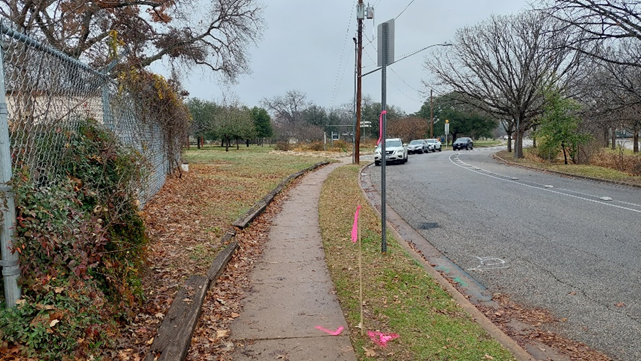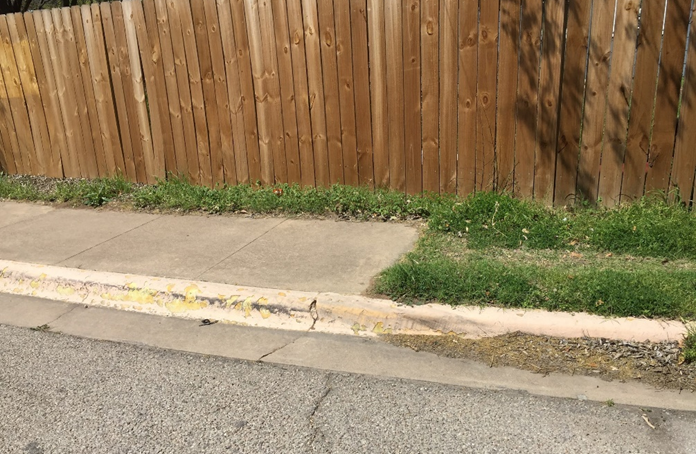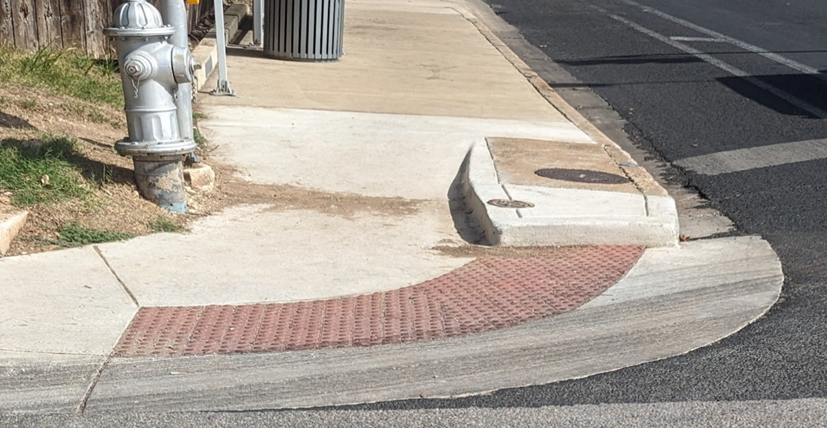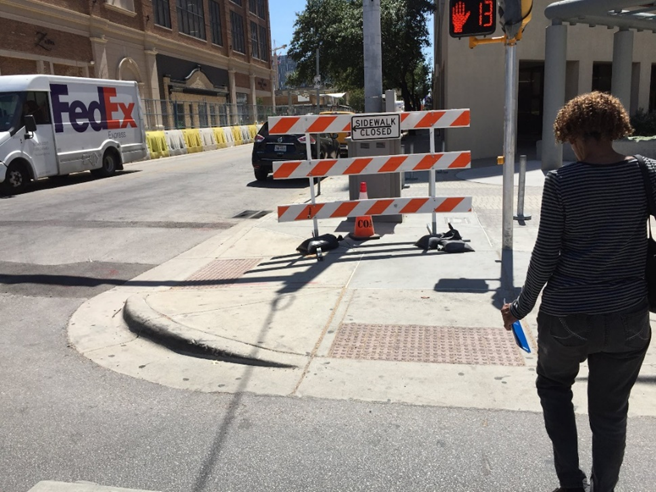The following article first appeared at Streetsblog USA.
Accessibility in the United States has been guided by the Americans with Disabilities Act since the 1990s — but it doesn’t touch on the public right of way. Fortunately, the Public Right-of-Way Accessibility Guidelines — also known as PROWAG — address this subject, but they don’t fully incorporate the input of individuals who need accessible infrastructure the most.
First, a little background
Adoption of the ADA and subsequent amendments have been the greatest achievements of the disability rights movement. Beyond that, the ADA remains a landmark achievement in civil rights in that it prohibits the discrimination of those with disabilities in areas such as employment, transportation, and education in public and private spaces.
Nonetheless, the ADA fails to address accessibility in areas known as the “public right-of-way,” which includes sidewalks, crosswalks, curb ramps, public transit stops, and more. PROWAG, written in 2011, has been considered best practice, but is not legally enforceable. Last year, PROWAG was adopted by the U.S. Access Board, but it still needs adoption by the departments of Justice and Transportation before it can truly make a life-changing impact for everyone who gets around in the public domain.
‘Accessibility is for everyone’
We often think of accessible design only being for those with a disability, but accessible infrastructure serves a much bigger purpose. Curb ramps help people in wheelchairs, the visually impaired, small children, caregivers pushing strollers, cyclists or scooter users and many others. Ramps and other accessible infrastructure make life easier for everyone; it is vital that they are designed correctly or even designed at all.
A great example of best practice to create accessible communities is 8 80 Cities, a Toronto-based not-for-profit founded by Gil Penalosa to help cities “move from talking to doing” by developing accessible public parks, promoting walkable and bike-friendly streets, and fostering well-being, physical activity and equitable access to healthy places. The organization operates under the idea that communities should be accessible for anybody in the range of an 8-year-old to an 80-year-old.
A prevailing sentiment of such efforts is best expressed by Andrea LaCour, co-Founder of Contour Collective: “We are all only temporarily able.” Indeed, all of us will experience a disability at some point in our lives, whether that be a diagnosed mental or physical disability, or simply old age. Mobility experts frequently evoke the need to keep in that it could be a loved one or even us one day struggling to use the infrastructure that is supposed to be designed to be accessible for all people.
Sidewalks and curb cuts
Among nine interviews with people of different backgrounds and specialties in the field of accessibility, the most frequently critiqued infrastructure was sidewalks and curb cuts. There are many easy fixes to improve sidewalks that simply aren’t done for what seems like a lack of care by governing bodies. Scott Meyer, Orientation and Mobility Specialist at the Criss Cole Rehabilitation Center, explained how one of the best things to improve sidewalks is simply keeping them clear of foliage and obstructions. Meyer uses a mobility cane to help navigate the public right-of-way and shared this experience.

Beyond this, there are many sidewalks that are designed poorly without taking users into account, such as sidewalks that end abruptly, intersect with driveways or simply don’t have curb ramps. Many more sidewalks aren’t regularly maintained or cleared of debris and may include cracks and other imperfections. As an example, about 80 percent of existing sidewalks in Austin, the Texas capital, are functionally deficient due to vegetation, maintenance, and obstructions, according to the City of Austin Sidewalk Master Plan.
Numerous lawsuits have been filed on this topic of sidewalks not being accessible; these are civil rights cases because not designing infrastructure with those with disabilities in mind is a discriminatory practice. These cases include but are not limited to:
- Betancourt-Colon v City of San Juan (2022)
- Hamer v City of Trinidad (2020)
- Liberty Resources v City of Philadelphia (2019)
- Dougherty v Allegheny County (2019)
- Reynoldson v City of Seattle (2015)
- Willits v City of Los Angeles (2013)
- Frame v City of Arlington (2010)
- Tinker v Town of Tilton (2005)
- Barden v City of Sacramento (2002)
These court cases span a significant period, showing how municipalities have had considerable time to bring sidewalks up to the conditions required by the 1991 ADA Accessibility Guidelines, yet many still fail to do so.

The biggest conflict in the realm of accessibility though seems to be the infamous, truncated dome. According to the U.S. Access Board, truncated domes, also known as detectable warnings, tactile paving, tactile warning surfaces, and an array of other names, are “a distinctive surface pattern of domes detectable by cane or underfoot that alert people with vision impairments of their approach to street crossings and hazardous drop-offs.”

Poorly placed bumps are a huge topic for disability advocates and a feature of PROWAG. Meyer said an important factor in the design of these domes is constructing them from a different material than the rest of the sidewalk — so that when a mobility cane hits this material, it will make a different sound.
But even more helpful, he said, is having the ramps designed to the proper slope, which PROWAG addresses, said Edward Erfurt, director of Community Action for Strong Towns. Meyer and Erfurt both noted that these truncated domes must be a different color than the rest of the sidewalk to visually stand out to users.
Truncated domes are often installed incorrectly, which defeats the purpose of alerting a pedestrian that she is about to enter the street. The result is confusion instead of clarity.
It’s important to consider the different people who might be using the infrastructure. Though domes help the visually impaired, they could be an obstacle to those in a wheelchair.
That’s why Nancy Crowther of ADAPT Texas, who uses a motorized wheelchair, likes what she calls “sidewalk braille,” which provides better traction to wheelchair users. Before the ADA, she said, there were flat ramps with lines on them that would fill up with water and freeze in the winter, creating a major safety hazard.
This also shows how important it is to take into consideration the input of all the different users of these domes in order to design them to be as accessible as possible for all people. There has been much progress on ramps and curb cuts through the ADA, but we still face challenges with how their design and installation have been implemented. There is continuously more progress to be made, and PROWAG will help when it comes to better specifying the ideal design and placement of these truncated domes.

Obviously, during construction projects, accessibility is frequently tossed to the curb. Yes, the construction project itself may lead to greater access, but if the temporary condition fails to do so, the entire design process needs to be reviewed and reworked.
Audible signals and crosswalks
For those with a vision or hearing disability, crossing the street can be a major safety concern. And often, the volume of an audible pedestrian signal is to low to be heard over traffic at busy intersections.
Crossing times are also frequently configured for drivers or able-bodied adult men, and with timing based on their walking speed. But many people move slower because of a disability, age, or even leg length. As a result, extremely unsafe situations are common. Even the placement of the button for triggering the audible signals is often in the wrong place, Crowther said.
The crosswalks themselves could pose a challenge to pedestrians and drivers. If crosswalks are not visible enough through frequent repainting, then drivers won’t know where to stop and people won’t know where to cross. If the crosswalk lines were maintained and repainted as needed to stay that bright white color, everyone can better cross the road safely.
Vehicle size
A major safety hazard is simply the increasing height of vehicles. As the truck and SUV market encourages the purchase of taller and taller trucks, the point at which these trucks would hit a pedestrian becomes more and more fatal. Some trucks and SUVs are now so tall that if a child or someone in a wheelchair were in front of the vehicle, the driver wouldn’t even be able to see them, as seen below.

Again, accessibility isn’t just for those experiencing a disability; it is also for children, the elderly, and all people who get around in public space. These larger SUVs and trucks operating in the public right-of-way make an unsafe space for children and those in wheelchairs to feel comfortable even crossing the road knowing that those operating the vehicles on the road may not be able to see them.
Conclusion
Accessibility should not be treated as an “afterthought,”said Tanya Lavelle of Disability Rights Texas. There is so much depth to the term “disability,” causing it to account for such a significant number of people who should not be excluded from the design process.
The Centers for Disease Control states that 61 million adults in the United States live with a disability. This is no minority and should not be treated as one in the design world. Accessible design provides for so many more people than those classified as having a disability, including children, bicyclists, and so many more. Having accessible infrastructure is a civil right that many of us take for granted in our day-to-day lives. People shouldn’t have to fight for the right to an accessible life.
Accessibility is for everyone.
